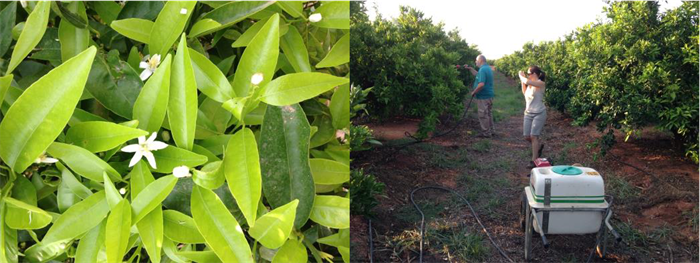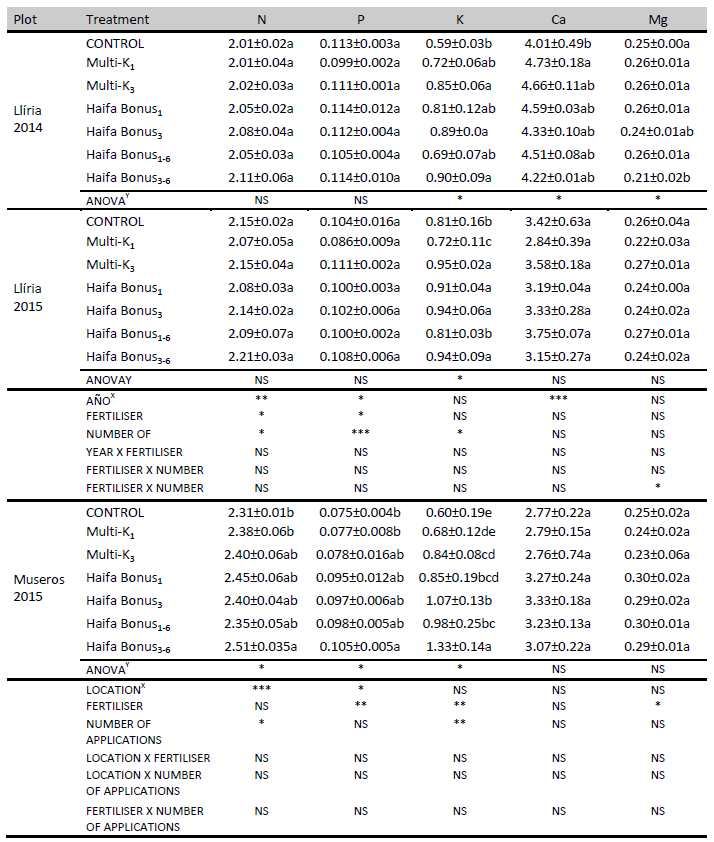Ana Quiñones1, José Manuel Fontanilla2
1Valencian Institute of Agrarian Research, Moncada (Valencia)
2Marketing Director at Haifa Iberia
OVERVIEW
The importance of potassium to plants is well known in the world of agriculture, as it is an essential macronutrient in plant development. The effect of applying this nutrient by foliar application in citrus crops has been studied by the Valencian Institute of Agrarian Research (IVIA) in Moncada (Valencia) for two years and in different plots, through the foliar application of Multi-K (potassium nitrate by Haifa) and Haifa Bonus™ (innovative foliar formula by Haifa that allows for spraying at high concentrations, reducing the number of applications needed) at different doses and application times. Our results show that trees treated using Haifa Bonus™ present potassium, nitrogen, calcium and magnesium contents greater than those found in untreated trees. They also tend to have greater yields, with fruits having a greater diameter and without affecting the organoleptic characteristics of the fruits.
1. INTRODUCTION
The importance of potassium to plants is well known in the world of agriculture, as it is an essential macronutrient in plant growth. Potassium acts as a regulator of osmotic pressure and is an irreplaceable element in the metabolic process of plants (photosynthesis, protein and carbohydrate synthesis). For this reason, it is fundamental in plant growth, in fruiting, in maturation, and in the yield quality of our crops. Therefore, a proper supply of this element is essential to obtain the highest yield and quality in our crops.
For the purpose of learning about the actual behaviour of potassium supplied by foliar application in the growing of citrus, using different formulations, doses and application times, the company HAIFA Iberia and the Valencian Institute of Agrarian Research (IVIA) signed a collaboration agreement for a period of two years, the results of which are presented in this article.
2. MATERIALS AND METHODS
For two consecutive seasons (2014-2015 and 2015-2016), the effect of the supply of potassium (K) by foliar application using different potassic fertilisers on the absorption of nutrients, the calibre of the fruit and the final yield of the crop was evaluated. In the second year of the trial, for the purpose of knowing whether the effect of the density of flowering on the response found was significant, the trial was carried out in two plots with a different intensity.
2.1 Plant material and crop conditions
The trial was carried out in two commercial plots of adult citrus plants of the Clementina de Nules variety, grafted onto carrizo citrange, planted on sandy loam. The first of them is located in the municipality of Llíria, where the trial of the first year of the study was carried out, and which displayed a very low intensity of flowering during the second season. The second one, in the municipality of Museros, displayed a much greater intensity of flowering. The theses studied (treatment types) were repeated 4 times, with each repetition covering 3 trees, with the study involving a total of 84 trees.
2.2 Studied formulations
trial, two fertilisers manufactured by the company HAIFA Iberia were studied:
Multi-K™ GG: Potassium nitrate (13.5-0-46.2)
Haifa Bonus™ 12-5-42: This is an innovative foliar formula that allows for high-concentration spraying, which reduces the number of applications needed. The Haifa Bonus formulas are enriched with phosphorus, which serves as a nutrient and reduces the pH of the solution to 4-5, making it appropriate for tank mixing with a wide variety of phytosanitary agents.
The Haifa Bonus formulas contain special adjuvants to achieve better adhesion to the leaf surface, greater absorption and longer action.
2.3 Studied theses
- The following treatments were evaluated in these plants:
- Treatment 0 or control, with no foliar applications – CONTROL
- An application of potassium nitrate (4%) in June – Multi-K™1
- An application of Haifa Bonus™ (4%) in June – Haifa Bonus 1
- An application of Haifa Bonus™ (6%) in June – Haifa Bonus 1-6%
- Three applications of potassium nitrate (4%) during fruit set, after the physiological fall of fruit and 30 days after this application – Multi-K™3
- Three applications of Haifa Bonus™ (4%) during fruit set, after the physiological fall of fruit and 30 days after this application – Haifa Bonus 3
- Three applications of Haifa Bonus™ during fruit set, after the physiological fall of fruit and 30 days after this application – Haifa Bonus 3-6%
During the first evaluation season (14-15), the study was carried out in a single location (Llíria). For the second season (15-16), the number of plots studied was increased to two (Llíria and Museros).
Table 1. Time of application of foliar treatments at the testing locations.

Photo 1. First foliar application of the treatments.
2.4. Statistical analysis
The significance of the treatments carried out was analysed using the statistical software Statgraphics Plus version 5.1 (Statistical Graphics, Englewood Cliffs, NJ), using one-way analysis of variance (ANOVA) with a comparison of averages using the LSD-Fisher test at a 95% confidence level, as well as three-way ANOVA, on:
- The results obtained in the Llíria plot analyse the effect of the yar (2014 and 2015), type of fertiliser (Multi-K and Haifa Bonus) and number of applications made (1 and 3)
- For the results of the year 2015, the effect of the location (Llíria and Museros) type of fertiliser (Multi-K and Haifa Bonus) and number of applications made (1 and 3) are evaluated
3. RESULTS AND DISCUSSION
The evaluation of the effect of the different fertilisers on plants of Clementina de Nules was performed through the measurement of different parameters:
3.1 Fruit growth
During the first season, fruit growth was measured monthly, from fruit set to harvest. Trees treated 3 times using Haifa Bonus™ tend to have fruits with a greater diameter from the month of August, despite there being no significant differences compared to the other treatments.
3.2 Foliar analysis
In the Llíria plot, the control plants (with no foliar application but with the same fertigation) displayed foliar concentrations below the range considered optimal for Clementina de Nules. This was not observed when potassium was applied foliarly. Despite having supplied foliar N in a greater quantity with the treatments (Table 2), no significant differences were observed in the foliar concentration of N. However, an upward trend in
this variable was observed as more N was supplied in 2015. On the ther hand, the differential supply of potassium (K) gave rise to significant differences in many of the elements
analysed. The foliar concentration of N and P was significantly higher in trees receiving Haifa Bonus with 3 applications compared to Multi-K as a source of K. Trees displayed significantly higher values of K when 3 foliar applications were made.
In Museros, there were also differences in the foliar concentration of the 3 primary macronutrients (N, P and K), obtaining higher values in treated trees compared to the control group. The leaves of trees receiving 3 applications of Haifa Bonus featured higher concentrations of N, P and K than the rest.
In general, the application of foliar treatments increased leaf concentration of elements supplied compared to the control group, observing that, as the application dose or the number of applications was increased, the leaf concentration of the macronutrients N and K increased in leaves, obtaining higher concentrations of these elements in leaves when there were three applications of Haifa Bonus per crop cycle (Table 2).
The results obtained for the foliar concentration of calcium (Ca) and magnesium (Mg) did not display a consistent pattern. The concentration of these elements in leaves depends on the fertilisation applied, concluding that, with an appropriate magnesium and calcium fertilisation, no antagonistic effect is observed between the K supplied foliarly and Mg and Ca.
Table 2. Concentration of macronutrients in the leaves budding in the spring without terminal fruitZ.

3.3. Organoleptic quality of the fruit, internal and external
Table 3 shows the values of the variables analysed in terms of fruit quality during the two seasons for the two study locations.
Fruit harvested from the plots did not present significant differences in terms of size, percentage of peel and juice and peel thickness, regardless of the treatments applied. However, there was a clear tendency towards obtaining fruits of a heavier weight and a larger size when potassium was supplied by foliar application in plots with normal yields (Llíria 2015 and Museros 2016), with this trend increasing when supplied using three applications of Haifa Bonus. In Museros, the use of 3 applications of Haifa Bonus at 6% gave rise to a significantly larger fruit diameter but with a higher percentage of peel and less juice than in the control trees, even though they were within the values considered normal for this variety.
Table 3. Quality of the fruit.
The total acid content increased significantly with foliar applications of K, with higher values after 3 applications. However, this did not affect the sugar contents of the juice significantly. These guidelines resulted in fruits receiving a higher dose of K presenting significantly lower maturity indices (Table 3).
3.4 Final yield
In both Llíria and Museros, the treatments applied gave rise to significant differences in the yields obtained, with higher values in trees receiving foliar applications of K, except for those that received 1 application of Multi-K in the Llíria plot in 2015 (Table 8).
The trees that received foliar applications of K tended to have higher yields. This increased after increasing the number of applications and the dose of K applied with Haifa Bonus.
Table 4. Final yield (Kg/tree) for test plotsZ.
4. FINDINGS
From the results obtained after analysing the effect of foliar applications of K through 1 or 3 applications of Multi-K or Haifa Bonus on the different parameters analysed, the following conclusions can be drawn:
-
K applications do not modify the seasonal growth of fruit
-
The use of three foliar applications of Haifa Bonus™ increases the foliar concentrations of N and P compared to control trees and those receiving a single application of Multi-K™
-
All potassic fertilisers applied foliarly (Multi-K™ and Haifa Bonus™) increase the concentration of K compared to control trees, to a greater extent when increasing the number of applications or the concentration of K
-
Fruit harvested from the plots did not present significant differences in terms of size, percentage of peel and juice and peel thickness, regardless of the treatments applied. However, there was a clear tendency towards obtaining fruits of a heavier weight and a larger size when K was supplied by foliar application, with this trend increasing when supplied using three applications of Haifa Bonus™
- Foliar applications of K using Multi-K™ and Haifa Bonus™ increased the yield obtained, with higher values regardless of flowering intensity. Despite there being no significant differences, an upward trend was observed in this parameter after increasing the number of applications in which Haifa Bonus™ was applied foliarly



